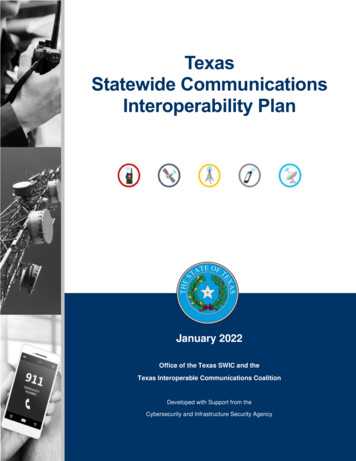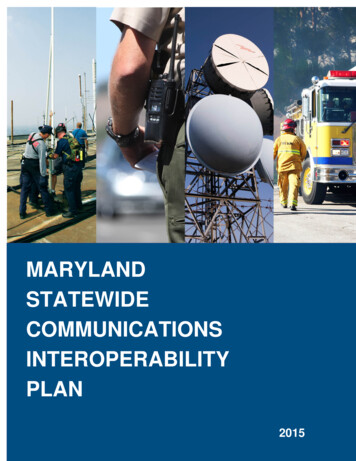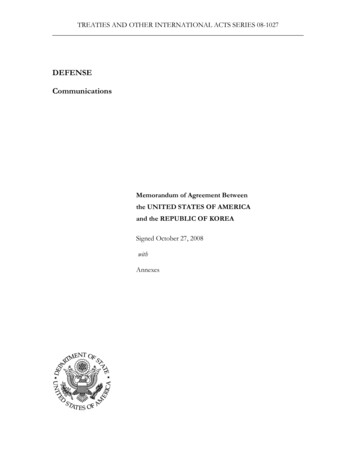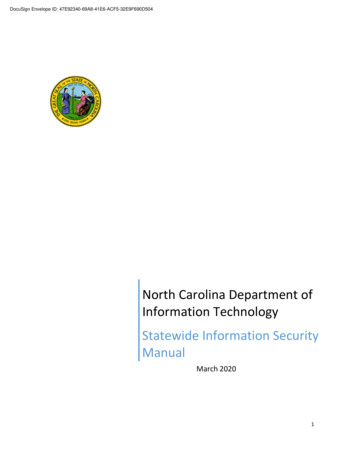
Transcription
TexasStatewide CommunicationsInteroperability PlanJanuary 2022Office of the Texas SWIC and theTexas Interoperable Communications CoalitionDeveloped with Support from theCybersecurity and Infrastructure Security Agency
This page intentionally left blank.
2021 TEXAS SCIPTable of ContentsLetter from the Statewide Interoperability Coordinator . 2INTRODUCTION . 3INTEROPERABLE AND EMERGENCY COMMUNICATIONS OVERVIEW . 4Vision and Mission . 51. Governance and Leadership . 5Texas Interoperable Communications Coalition (TxICC) . 52.3.4.5.Planning and Procedures . 6Training, Exercises and Evaluation . 6Communications Coordination . 6Technology, Infrastructure and Funding . 7Land Mobile Radio . 7Mobile Broadband . 7Next Generation 911 . 7Alerts and Warnings. 7Funding . 76. Cybersecurity . 7Implementation Plan. 8Appendix A: State Markers . 15Appendix B: Acronyms . 16i
2021 TEXAS SCIPLetter from the Statewide Interoperability CoordinatorGreetings,As the Texas Statewide Interoperability Coordinator (SWIC), I am pleased to provide to you the 2022Texas Statewide Communications Interoperability Plan (SCIP). This SCIP represents Texas’continuous commitment to improving emergency communications interoperability and supporting ourpublic safety practitioners throughout the state. In addition, this meets the requirement of having anupdated SCIP in the current U.S. Department of Homeland Security (DHS) grant guidelines.Representatives from several Texas Council of Governments (COGs) participated in a virtual SCIPWorkshop on April 7, 2021 to review and update goals and initiatives in the 2020 Texas SCIP. Thesegoals and initiatives align closely with the 2019 National Emergency Communications Plan (NECP),with a focus on Governance and Leadership; Planning and Procedures; Training, Exercises, andEvaluation; Communications Coordination; Technology, Infrastructure, and Funding; and Cybersecurity.On December 15, 2021 the SEC Delegates met via webinar to approve administrative changes to theSCIP. The SEC approved updating the SCIP on a biennial schedule.As we continue to enhance interoperability, we must remain dedicated to improving our ability tocommunicate among disciplines and across jurisdictional boundaries. With help from public safetypractitioners statewide, we will work to achieve the goals set forth in this SCIP and continue to be anationwide model for statewide interoperability.Sincerely,Karla JurrensTexas Statewide Interoperability CoordinatorTexas Department of Public Safety2
2021 TEXAS SCIPINTRODUCTIONThe Texas SCIP is a stakeholder-driven, multi-jurisdictional, and multi-disciplinary strategic plan toenhance interoperable and emergency communications over the next one-to-three years. Thisdocument contains the following planning components: Introduction – Provides the context necessary to understand what the SCIP is and how it wasdeveloped. It also provides an overview of the current emergency communications landscape. Interoperable and Emergency Communications Overview – Provides an overview of Texas’current and future emergency communications environment. Vision and Mission – Articulates Texas’ vision and mission for improving emergency and publicsafety communications interoperability. Goals and Objectives – Outlines the goals and objectives aligned with the vision and mission ofthe SCIP as they pertain to Governance, Technology, and Funding. Implementation Plan – Describes Texas’ plan to implement, maintain, and update the SCIP andenable continued evolution of and progress toward Texas’s interoperability goals.The Emergency Communications Ecosystem consists of many inter-related components and functions,including communications for incident response operations, notifications and alerts and warnings,requests for assistance and reporting, and public information exchange. The primary functions aredepicted in the newly released 2019 NECP 1.0FThe Interoperability Continuum, developed by the Department of Homeland Security’s SAFECOMprogram and shown in Figure 1, serves as a framework to address challenges and continue improvingoperable/interoperable and public safety communications. It is designed to assist public safety agenciesand policy makers with planning and implementing interoperability solutions for communications acrosstechnologies. More information is available in the Interoperability Continuum brochure.2122019 National Emergency Communications PlanSAFECOM Interoperability Continuum brochure3
2021 TEXAS SCIPFigure 1: SAFECOM Interoperability ContinuumINTEROPERABLE AND EMERGENCY COMMUNICATIONSOVERVIEWInteroperability is the ability of emergency response providers and relevant government officials tocommunicate across jurisdictions, disciplines, and levels of government as needed and as authorized.Reliable, timely communications among public safety responders and between public safety agenciesand citizens is critical to effectively carry out public safety missions, and in many cases, saving lives.Traditional voice capabilities, such as land mobile radio (LMR) and landline 911 services have longbeen and continue to be critical tools for communications. However, the advancement of internetprotocol (IP) based technologies in public safety has increased the type and amount of informationresponders receive, the tools they communicate with, and complexity of new and interdependentsystems. New technologies increase the need for coordination across public safety disciplines,communications functions, and levels of government to ensure emergency communications capabilitiesare interoperable, reliable, and secure.An example of this evolution is the First Responder Network Authority’s (FirstNet) implementation of theNationwide Public Safety Broadband Network (NPSBN). Similarly, the transition of public-safetyanswering points (PSAPs) to Next Generation 911 (NG911) technology will enhance sharing of criticalinformation in real-time using multimedia—such as pictures, video, and text — among citizens, PSAPoperators, dispatch, and first responders. While potential benefits of NG911 are tremendous,implementation challenges remain. Necessary tasks to fully realize these benefits include interfacingdisparate systems, developing training and standard operating procedures (SOPs) and ensuringinformation security.4
2021 TEXAS SCIPVision and MissionThis section describes Texas’ vision and mission for improving emergency communications operability,interoperability, and continuity of communications statewide:Vision:All public safety and incident response entities in Texas will have access to effective andsustainable wireless interoperable voice and data communications.Mission:Through the unified voice and collaborative efforts of the TxICC and the SWIC Office, achieveeffective voice and data communications interoperability across Texas.1. Governance and LeadershipSCIP Goal: All public safety and incident response entities in Texas will have access to effective andsustainable wireless interoperable voice and data communications.Texas Interoperable Communications Coalition (TxICC)The Texas Interoperable Communications Commission (TxICC) is the current governance body inplace for emergency communications for the State of Texas and is housed in the Texas Department ofPublic Safety (DPS). The TxICC is comprised of public safety communications representatives frompublic safety and incident response entities across the state and maintains chartered responsibility ofthe SCIP. The TxICC established the SCIP Executive Council (SEC) to serve as the official voting entityof the TxICC. The SWIC chairs both the SEC and the TxICC and oversees the implementation of allSCIP goals and initiatives. The SWIC is supported by ad-hoc Strategic Advisory Groups (SAGs), whichadvise the SWIC on key issues such as public safety broadband, developing a system of systems,improving training and exercises, and updating the Texas Statewide Interoperability Channel Plan.The TxICC is a voluntary organization of federal, state, local, tribal, and non-profit entities, includingtraditional emergency communications disciplines as well as public utilities, critical infrastructure/keyresources providers, and transportation agencies. The TxICC owns and manages the SCIP as astrategic planning tool to help Texas public safety agencies prioritize resources, strengthengovernance, identify future investments, and address interoperability gaps. The SWIC provides5
2021 TEXAS SCIPoversight and leadership to the TxICC SAGs, as they address key issues such as the Texas PublicSafety Broadband Program, training and exercises, and funding.Texas’ governance structure is depicted in Figure 2 below.Figure 2: Texas's Emergency Communications Governance Structure2. Planning and ProceduresSCIP Goal: Develop and update comprehensive emergency communications plans, procedures, andtools that address the evolution of risks, capabilities, and technologies.3. Training, Exercises and EvaluationSCIP Goal: Develop and deliver training curriculum, exercise templates, and evaluation methods thattarget gaps in all emergency communications technologies.4. Communications CoordinationSCIP Goal: Provide public safety and incident response agencies with best practices to addressinteroperability opportunities and challenges posed by technology advancements related to incidentresponse.6
2021 TEXAS SCIP5. Technology, Infrastructure and FundingSCIP Goal: Identify funding sources available to local, regional, Tribal, and State agencies forcommunications equipment, training, and maintenance of systems.Land Mobile RadioTexas supports adoption of P25 Land Mobile Radio (LMR) systems and where feasible sharinginfrastructure and resources by joining and sharing network core services with existing RegionalPublic Safety Radio Systems. Grant funding will only be approved to purchase P25 radioequipment (if encryption is purchased, it must be AES-256).Mobile BroadbandTexas continues to support the buildout and adoption at the agency level for the implementationof FirstNet, the National Public Safety Broadband Network (NPSBN) as well as the adoption ofmobile broadband applications that enable interoperable data and information sharing betweenagencies.Next Generation 911Through the Texas Commission on State Emergency Communications (CSEC), the State ofTexas has a 9-1-1 strategic plan in place and continues development and integration with thecontract provider for Emergency Services Internet Protocol (IP) Networks (ESInet).Alerts and WarningsAlerts and Warning in Texas are supported by the Texas Division of Emergency Management(TDEM) Alerts and Warnings program including the Integrated Public Alerts and WarningsSystem (IPAWS).FundingAchieving sustainable funding across all levels of government for public safety communicationsremains a challenge. Federal grants continue to decrease, and state and local entities continueto identify a need for funding to support training efforts, equipment upgrades and maintenance,and the preservation and operation of existing systems. For this reason, the State of Texaspromotes alternative approaches to funding such as encouraging state and local infrastructuresharing agreements. While this is not the sole approach to solving funding challenges, it is anopportunity for Texas to encourage interagency collaboration and engagement.6. CybersecuritySCIP Goal: Offer outreach support to provide updates, best practices, and monitoring of industrydevelopments, and direction to current resources.7
2021 TEXAS SCIPImplementation PlanThe National Emergency Communications Plan (NECP) establishes objectives for the continuedimprovement of emergency communications for the Nation. Texas has adopted the following initiativesin alignment with the NECP. These SCIP goals and initiatives are intended to support the disseminationof best practices across Texas and can be amended as relevant stakeholders see fit. Each initiativehas a timeline with a targeted initial completion date, and one or multiple owners that will beresponsible for overseeing and coordinating its completion. Accomplishing goals and objectives willrequire the support and cooperation from numerous individuals, groups, or agencies. The CISAEmergency Communications Division (ECD) has a catalog of technical assistance service offeringsavailable to assist in implementation of the SCIP.3 Requests for assistance are to be coordinatedthrough the SWIC.3FY20 TA/SCIP Guide8
DRAFT TEXAS STATEWIDE COMMUNICATIONS INTEROPERABILITY PLAN – FEBRUARY 20201. Governance and LeadershipSCIP Goal: Texas shall establish and support effective communications governance which includes emergency communications and ment#InitiativesOwnerDate1.1Maintain the SWIC Office and the formal governance body,the TxICC, by maintaining the SCIP and through inclusivestakeholder engagements, and by reviewing governancedocuments to include emerging technologiesSWICOdd numberedyearsT1.2Maintain Regional Interoperable CommunicationsCommittees (RICCs) in all 24 COGs including the threeTribes and conduct meetings annually at a minimumCOGs,TribesOngoingSVerified through Focus Group (FG)Report1.21.3On an annual basis review and revise local and Tribal pointsof contact lists including emergency communicationsstakeholders, SEC delegates, radio programmers, ID plancontacts, and COMU contacts and any new subject matterexperts identified in the annual FG ReportCOGs,Tribes,SWICJanuary,annuallyTUpdated contact lists submitted withannual FG report1.2COGs,Tribes,TexasAssociationof RegionalCouncilsJanuary,annuallySVerified through FG reports1.2COGs,January,annuallyTVerified through FG report1.3SCIP evaluated biennially1.1TxICC charter evaluated every fouryearsWork to add cybersecurity and 9-1-1 stakeholders astechnology interests are converging1.4Educate state, local, tribal, and regional decision makersand elected officials on the importance of all aspects ofinteroperable communications and the need to fund andsustain systems1.5Locally or regionally hold at least one informationexchange/demonstration session with stakeholders (possiblyin conjunction with an existing regional public event) toshare agency mission, initiatives, deployable assets, andany other available resources that could be used for regionalor statewide responseTribes9
DRAFT TEXAS STATEWIDE COMMUNICATIONS INTEROPERABILITY PLAN – FEBRUARY 20201.6Develop legislative report of statewide progress towardsinteroperability and SCIP initiatives based on RICC FocusGroup ReportsSWICJune, annuallyTCompleted report1.31.7Maintain the Texas Statewide Interoperability Channel Plan(TSICP), eTXFOG and affiliated Memoranda ofUnderstanding (MOUs) and post to a shared locationTSICPSAGOngoingTUpdate TSICP, as required1.3Inform stakeholders on new technology and cybersecurityupdates with the TxICC newsletter (including urgent noticesas required)SWIC1.8 eTXFOG available on app stores list of MOU signees posted on DPSwebsiteSWICOngoingTNewsletters and Notices1.32. Planning and ProceduresSCIP Goal: Develop and update comprehensive emergency communications plans, procedures, and tools that address the evolution ofrisks, capabilities, and technologies#Initiatives2.1Engage RICC to complete annual Focus Group andInteroperability Level reports, using surveys, webinars ormeetings to identify and prioritize needs and plans forinteroperability for each of the COGs and Tribes, anddetermine if tools or best practices need to be tricNECPAlignmentJanuary,annuallySCompleted FG and InteroperabilityLevel surveys2.1SWIC2.2Review, update, and maintain resources in common sharedsecure locationsSWICOngoingmaintenanceSAnnual review of information and fileson shared sites to ensure informationis up to date. (CASM, HSIN, DPSwebsite)2.12.3COGs update the capabilities and migration sections ofRICPs (also any other RICP sections or informationrequiring updates)COGs,TribesOngoingSUpdated RICP reports2.2Verified through FG report10
DRAFT TEXAS STATEWIDE COMMUNICATIONS INTEROPERABILITY PLAN – FEBRUARY 20202.4Encourage agencies to develop a cybersecurity incidentresponse plan by providing best practice guidanceCOGs,Local,TribalOngoingSProvide Best Practice documents2.3Verified through FG reportSWIC3. Training, Exercises and EvaluationSCIP Goal: Develop and deliver training curriculum, exercise templates, and evaluation methods that target gaps in all emergencycommunications cMetricNECPAlignment3.1Develop a basic interoperable radio training curriculumavailable online promoting the use of interoperabilitychannels and TalkGroupsSWICOctober 2022STraining available online3.13.2Engage accrediting organizations as appropriate to adoptinteroperable radio communications curriculum as part ofcontinuing education programsSWICOctober 2022TCompile and contact list ofaccrediting organizations and POCs3.1SWIC,COGs,LocalJanuary,annuallyTCompleted radio communicationsdrill ies conduct regular drills to practice use ofinteroperability channels / TalkGroups; examples include: Regular rollcalls on interoperability channels /TalkGroups Parking lot drill included in Basic Radio Trainingcourse Regular communications drill integrated withannual required trainingConduct/participate and promote multi-agency exercisesannually and develop communications-focused after-actionreports (AARs) to identify the effectiveness and use ofinteragency communications RSOPs, and compliance withthe National Incident Management (NIMS)/IncidentCommand System (ICS)Verified through FG ReportTCompleted multi-agency exerciseand AAR3.1Verified through FG report11
DRAFT TEXAS STATEWIDE COMMUNICATIONS INTEROPERABILITY PLAN – FEBRUARY 20203.5Identify a COMU single point of contact for each COG andTribe. POCs will maintain the list of COMU personnel inCASM for their area.COGs,TribesJanuary, annualmaintenanceTData uploaded and maintained in theCommunications Assets Survey andMapping Tool (CASM) database3.3Verified through FG Report4. Communications CoordinationSCIP Goal: Provide public safety and incident response agencies with best practices to address interoperability opportunities and challengesposed by technology advancements related to incident Monitor and share industry and government advancementsand best practices in communications during the annualTxICC ConferenceSWICAnnuallyT4.2Regularly review and update local, tribal, and regional assetinventories in the CASM databaseCOGs,TribesOngoingTVerified through FG reports4.24.3Coordinate with emergency alerts and warnings and NG911organizations and provide updates and best practices tostakeholdersSWIC,State 911Districts,TDEMOngoingTNG911 and A&W updates providedannually at minimum, generally atTxICC annual conference4.24.4Update Regional SOPs (RSOPs) as needed; distribute to alllocal, tribal, and mutual aid responder agencies in the regionCOGs,TribesBi-annually/TUpdated RSOPs uploaded to HSIN4.2Share resources and best practices among federal, state,tribal, regional, and local entities that highlightinteroperability improvements and cost MetricAt least one SWIC presentation ormessage to TxICC annuallyNECPAlignment4.2RICCs share with localstakeholders.JanuaryVerified through FG reportSConduct annual System ManagersMeeting4.212
DRAFT TEXAS STATEWIDE COMMUNICATIONS INTEROPERABILITY PLAN – FEBRUARY 20205. Technology and InfrastructureSCIP Goal: Identify funding sources available to local, regional, Tribal, and State agencies for communications equipment, training andmaintenance of ansition public safety radio systems to comply with P25standards for statewide interoperabilityCOGs,Tribes,SWICOngoingTVerified through technologyinteroperability levels identifiedannually by COGs and Tribesthrough the level of ngoingSVerified through FG reports5.2OngoingTVerified during grant process SWICApproval5.25.25.35.4Program all public safety and incident response entitysubscriber radios with TSICP-designated interoperabilitychannels and applicable interoperability TalkGroupsVerify public safety agencies have executed the TSICPMOUExplore public safety information sharing applications forthe potential development of (suggested, sanctioned,approved?) application listCOGsTribesLocalSWICSWICBB SAGMetricNECPAlignment#Verified through FG reports2022 TxICCConferenceSList of applications to recommend5.313
DRAFT TEXAS STATEWIDE COMMUNICATIONS INTEROPERABILITY PLAN – FEBRUARY 20206. CybersecuritySCIP Goal: Offer outreach support to provide updates, best practices, and monitoring of industry developments, and direction to Date6.1Conduct a Cybersecurity Awareness Month webinarSWICOctober,annuallyTCompletion of webinar, can be inconjunction with TxICC Conference6.16.2Encourage agencies to conduct Cybersecurity ThreatAssessments by providing best practice guidanceSWICOngoingTProvide Best Practice documents6.1Actively share best practices standards and frameworks forcybersecurity from National Institute of Standards andTechnology (NIST) and the Cybersecurity and InfrastructureSecurity Agency (CISA) on HSINSWICExplore a system owner real-time cybersecurity informationsharing portalSWIC6.36.4MetricNECPAlignment#Verified through FG reportMonthlyuploads,SOngoingSystemManagers2022 TxICCConferenceBest practices and standardsuploaded to HSIN6.2Share Texas Department of PublicSafety (DPS) Cyber NewsletterSAcceptance by the TxICC6.2Implement shared portal14
DRAFT TEXAS STATEWIDE COMMUNICATIONS INTEROPERABILITY PLAN – FEBRUARY 2020Appendix A: 2021 State MarkersIn 2019, CISA supported states and territories in establishing an initial picture of interoperability nationwide by measuring progress against 25markers. These markers describe a state or territory’s level of interoperability maturity. Below is Texas’ 2021 assessment of their progress againstthe markers.15
DRAFT TEXAS STATEWIDE COMMUNICATIONS INTEROPERABILITY PLAN – FEBRUARY 2020Appendix B: PP25DefinitionAfter-Action ReportAuxiliary CommunicationsCommunication Assets Survey and MappingCybersecurity and Infrastructure Security AgencyCouncil of GovernmentsCommunications Unit LeaderCommunications Unit TechnicianCommunications Unit ProgramContinuity of Operations PlanCommission on State Emergency CommunicationsDepartment of Homeland SecurityDepartment of Public SafetyEmergency Management ServicesEmergency Services Internet Protocol NetworkTexas Electronic Field Operations GuideField Operations GuideGeospatial Information SystemHomeland Security Information NetworkIncident Command SystemInteroperable Communications Technical Assistance ProgramIncident Communications Center ManagerIncident Tactical DispatcherInternet ProtocolIntegrated Public Alerts and Warnings SystemInformation Technology Service Unit LeaderLaw Enforcement OfficerLand Mobile RadioMemorandum of UnderstandingNational Emergency Communications PlanNext Generation 9-1-1National Incident Management SystemNational Institute of Standards and TechnologyNational Public Safety Broadband NetworkPoint of ContactPublic Safety Answering PointProject 2516
DRAFT TEXAS STATEWIDE COMMUNICATIONS INTEROPERABILITY PLAN – FEBRUARY PSWICTATDEMTERTTICPTSCIPTxICCWPSDefinitionRadio OperatorRegional Interoperable Communications CommitteeRegional Interoperable Communications PlanRegional Planning CommissionRegional Standard Operating ProcedureStrategic Advisory GroupStatewide Communication Interoperability PlanStatewide Communication Interoperability Plan Executive CouncilStatewide Interoperability Executive CommitteeStatewide Interoperability Governing BoardStandard Operating ProcedureStatewide Interoperability CoordinatorTechnical AssistanceTexas Department of Emergency ManagementTelecommunications Emergency Response TeamTactical Interoperable Communications PlanTexas Statewide Interoperability Channel PlanTexas Interoperable Communications CommissionWireless Priority Service17
The Emergency Communications Ecosystem consists of many inter-related components and functions, including communications for incident response operations, notifications and alerts and warnings, requests for assistance and reporting, and public information exchange. The primary functions are depicted in the newly released 2019 NECP 0F1.










